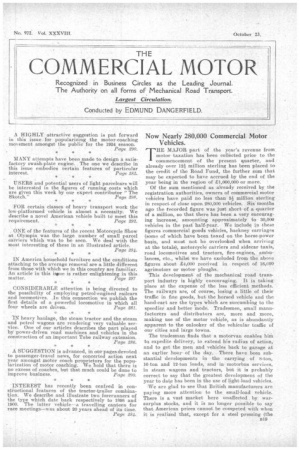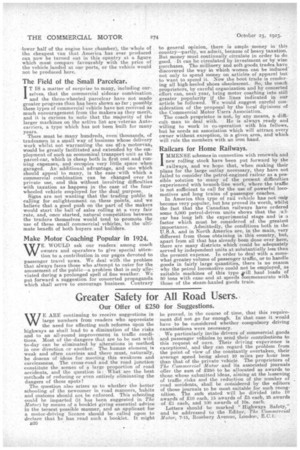Now Nearly 280,000 Commercial Motor Vehicles.
Page 1

Page 2

If you've noticed an error in this article please click here to report it so we can fix it.
THE MAJOR part of the year's revenue from. motor taxation has been collected prior to the commencement of the present quarter, and already over 124, million sterling has been placed to the credit of the Road Fund, the further sum that may be expected to have accrued by the end of the year being in the region of £1,000,000 or more. '
-Of the sum mentioned as already received by the registration authorities, owners of commercial motor vehicles have paid no less than 512million sterling in respect of close upon 280,000 vehicles. Six months ago the tecorded figure was just short of a quarter of a million, so that there has been a very encouraging increase, amounting approximately to 30,00l) vehicles in the past. half-year. :We include in these figures 'commercial goods vehicles, hackney carriages (some of which have been taxed on the horse-power basis, and must not be overlooked when arrivieg at the totals), motorcycle carriers and sidecar taxis,' road locomotives and tractors, fire-engines, ambulances, etc., whilst we have excluded from the above figures about 24,009 received in respect of 16,000 agritnotors or motor uloughs.
This development of the mechanical road trans port industry is highly 'encouraging. It is taking place at the expense of the less efficient methods. The railways are, of course, losing a little of their traffic in fine goods, but the horsed vehicle and the hand-cart are the types which are succumbing to the speedierand better mode. Tradesmen, small manufacturers and distributors are, more and more, making use of the motor vehicle, as is abundantly apparent to the onlooker of the vehicular traffic of our cities and large towns.
The tradesman finds that a motorvan enables him to expedite delivery, to extend hie radius of action, and to get the men and vehicles back to garage at an earlier hour • of the day. There have been substantial developments in the carrying of 8-ton, 10-ton and 12-ton loads, and in motorbus services, in steamwagons and tractors, but it is probably correct to say that the greatest development of the year to date has been in the use of light-load vehicles.
We are glad to see that British manufacturers are paying more attention to the small-load vehicle. There is a vast market here unaffected. by warsurplus stocks, and it is no longer possible to say that American prices cannot be competed with when it is realized that, except for a steel pressing (the -lower half of the engine base chamber), the -whole of the cheapest van that America has ever produced can now be turned out in this cguritry at a figure which must compare favourably with the price of the vehicle landed at our ports, or the vehicle would not be produced here.
The Field of the Small Parcekar.
IT IS a matter of surprise to many, including ourselves, that the commercial sidecar combination, and the three-wheeled parcelcar have not made greater progress than has been shown so far ; possibly these types of commercial vehicle have not received as much encouragement from the makers as they merit, and it is curious to note that the majority of the larger machines on the active list are veteran Autocarriers., a type which has not been built for many years. There must be many hundreds, even thousands, of tradesmen in a small way of business whose delivery work whilst not warranting the use of ta-motorvan, would be greatly facilitated and extended by the employment of such an economical transport unit as the parcel-car, which is cheap both in first cost and running expenses, and occupies very little space when. garaged. An • additional advantage, and one which should appeal to many, is the ease with which a commercial combination can be changed over to private use, and this without involving difficulties with taxation as happens in the case of the fours wheeled vehicle employed for the dual purpose. Signs are not wanting that the trading public is calling for enlightenment on these points, and we believe that a good push on the part of the makers would start the ball ofsales rolling at a very fair rate, and, once started, natoral comnetifion between the traders themselves would tend to promote the use of these small commercial vehicles, to the ultimate benefit of both buyers and builders.
Make Motor Coaching Popular in 1924.
WE WOULD ask our readers among coach owners and operators to give special attention to a contribution in our pages devoted to passenger travel news. We deal with the problem that always faces those who attempt to cater for the amusement of the public—a problem that is only alleviated during a prolonged spell of fine weather. We put forward a, suggestion for concerted propaganda which shall serve to encourage business. Contrary to general opinion, there is ample money in this country—partly, we admit, because of heavy taxation. But money must continually circulate in order to do good. It can be circulated by investment or by wise purchases. The millinery and soft. goods trades have discovered the way in which women can be induced" not only to spend money on articles of apparel but to Want to spend it. Now the boot trade is rendering all high-heeled•,shoes obsolescent. So, the coach proprietors, by careful organization and by concerted effort can, next year, bring motor coaching into still greater popularity if the lines indicated in our article be followed. We would .suggest careful consideration of the proposal by the local diyisions of the Commercial Motor Users Association. The coach proprietor is not, by any means, a difficult man to deal with. He is always ready and willing to work in co-operation with his fellows, but he needs an association which will attract every owner without exception, in a given, area, and which will rule the members with an iron hand.
Railcars for Home Railways.
IMMENSE schemes in connection with renewals and new rolling stock have been put forward by the railways, and we hope that, when making their plans for the large outlay necessary, they have not failed to consider the petrol-engined railcar as a possible solution to many of the present difficulties experienced with branch-line work, where the traffic is not sufficient to call for the use of powerful locomotives and long trains of .passenger coaches. In America this type of rail vehicle has not nista, become very popular, but has proved its worth, whilst the fact that the Canadian railways have ordered some 5,000 petrol-driven units shows that the :ailcar has long left the experimental stage and is a factor which must be considered of. the greatest importance. Admittedly, the conditions both in the U.S.A. and in North America. are, in the main, very different from those obtaining in this country, but, apart from all that has already been done over here, there are many districts which could be adequately served by independent units at substantially less than the present expense. In order to deal with a somewhat greater volume of passenger traffic, .or to handle goods in fairly large quantities, there is no reason why the petrol loconlotive could not be employed, as suitable machines of this type iivill haul loads of 50 tons with ease and at speeds aommensur ate with those of the steam-hauled goods train.






























